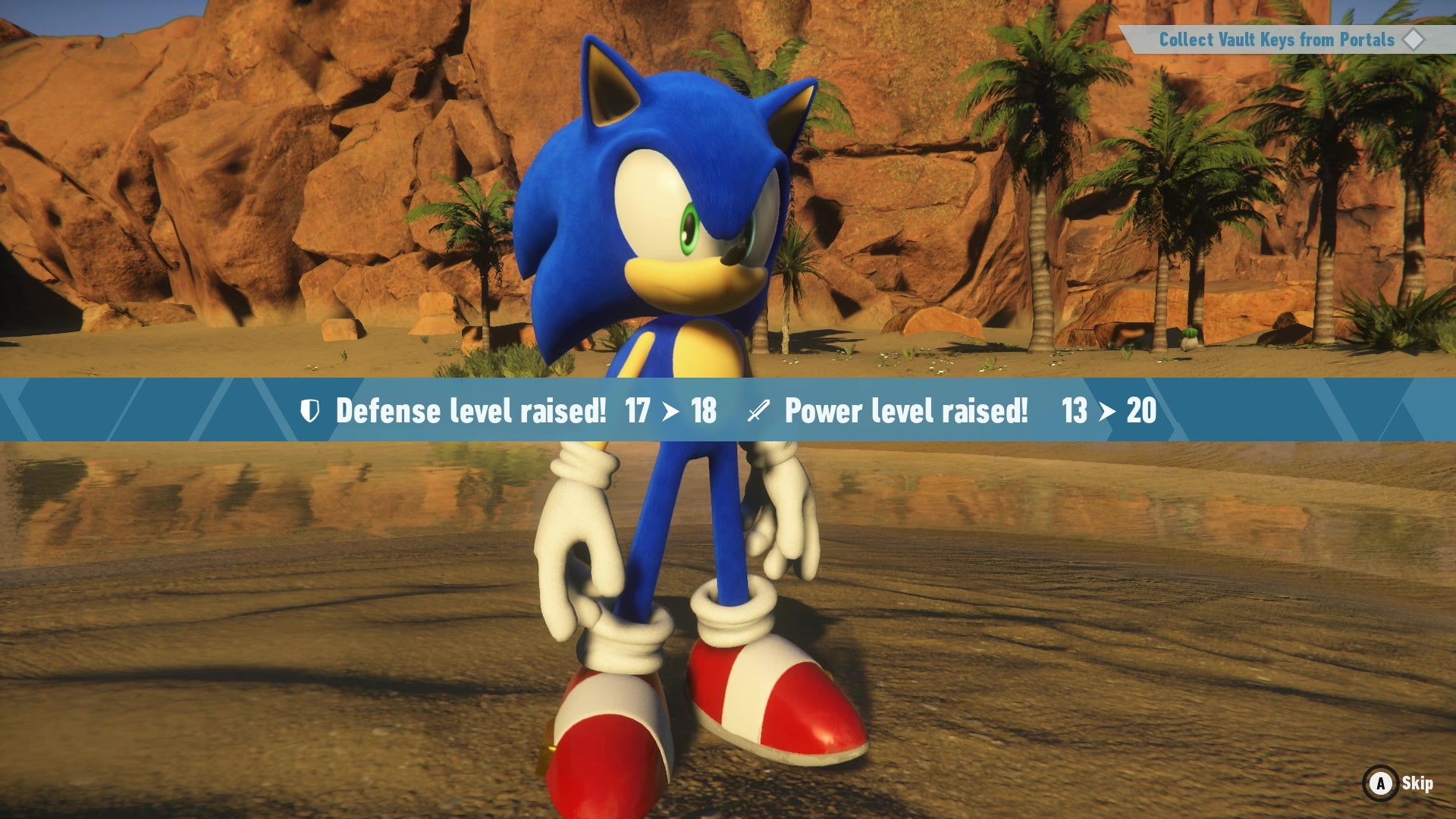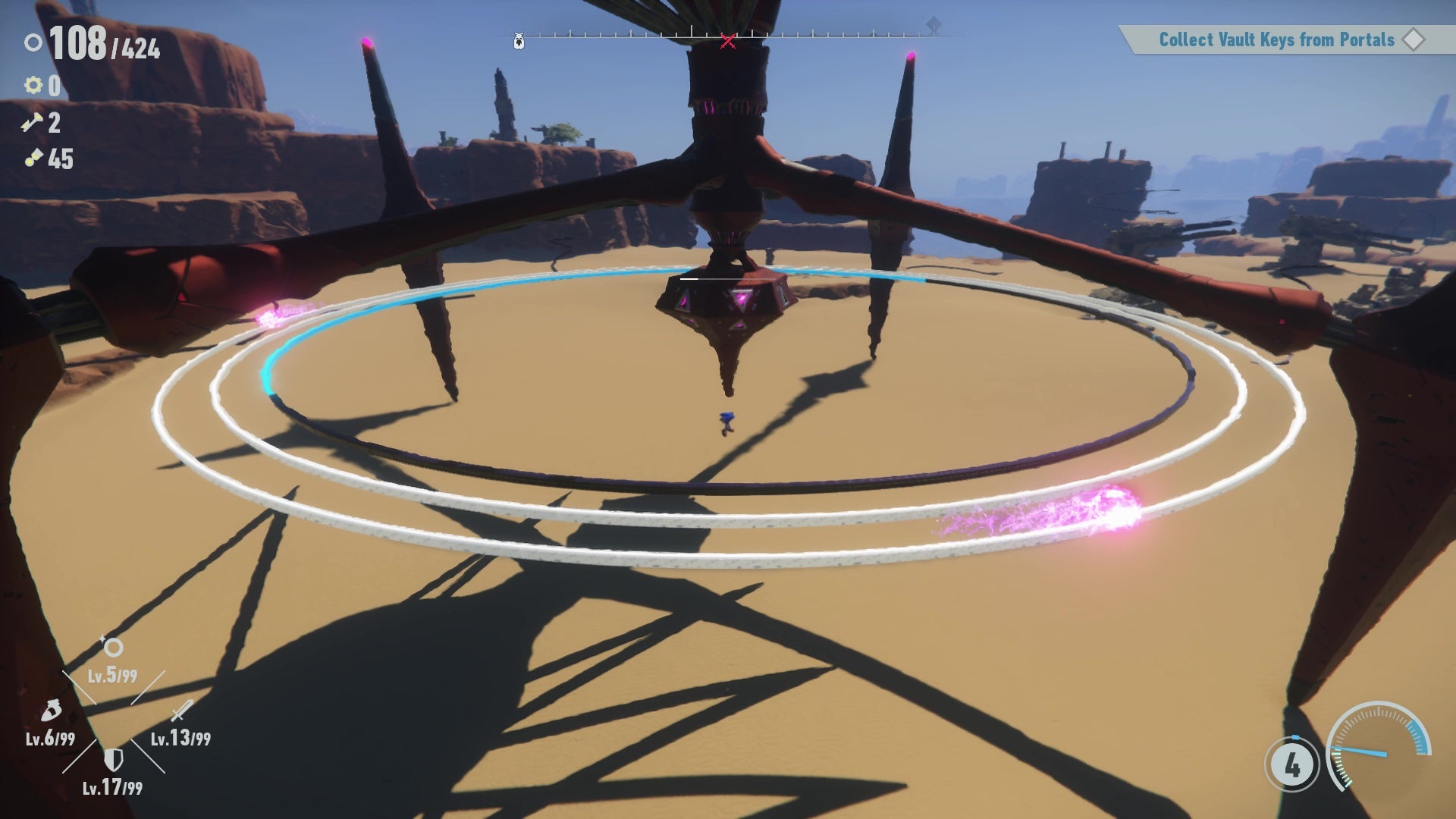The game’s story opens with a bang as Dr. Eggman gets sucked into this portal which traps him in Cyberspace (some AI-controlled realm), while Sonic and his pals also suffer the same fate (to some extent). There are also these smiley rock things called Kocos that seem to be remnants of an ancient civilisation that underwent some form of apocalyptic collapse. You got all that down? Good, okay. So anyway, it’s your job as Sonic to like, free your pals and help these rock people and stop Dr. Eggman’s nefarious plans as per. To stop Dr. Eggman and save the world, Sonic must navigate “open zones” as opposed to an open world, so it’s far more like Mario Odyssey than it is Breath Of The Wild. Your job as Usain Hog is to scoop up lots of tokens and skill shards and gears to reach The Big Bad of said zones and whizz them into the nether. Like many other platformers, it’s very much a collectathon, only this time home to Sonic’s signature scaffolds that accommodate a great variety of sometimes janky, sometimes confusing, but often thrilling offshoots. The game’s open zones are vast and first obscured with a fog of war, which you’re able to uncover gradually by exploring and ticking off simple – and sometimes weirdly conceptual - activities like: reach the glowing pad over yonder before the timer runs out, or draw a magical loop around several glowing spheres. As the map’s fog dissipates, more icons pop up in its place, drawing you to lots of bitty activities that result in one of many collectibles. Dotted around lush greenland and Death Stranding-esque mountainsides, you’ll find plentiful rails on which to slide that lead to bounce pads and swingy sections. And there’s a real joy in zipping between them all and hearing the ding ding ding of coins ring out as you pocket whatever token gains you access to the nearest Portal. You see, it’s the ultimate piss about. I’m serious! You will be hard pressed to find a better virtual space in which to scurry across all sorts of disconnected bits. There is a caveat to the game’s bittyness, though, as it sees you go fast in all manner of directions, to the point where it’s totally directionless. Rails and platforming bits rarely work in tandem and are often independent catapults that’ll fling you any which way. When they do toss you over to a fellow connective piece, it’s an immediate dopamine rush brought about by sensations of speed coupled with smoothness that can’t be emulated anywhere other than a Sonic game. But more often than not, you’re unable to pinpoint your location purely by your surroundings, which lends zones a slightly soulless character. Lush music and robotic flying squids aside, total reliance on your map means they’re as lively as the monkey bars in your local playground. And the minute you decide that you’ve had enough of pissing about and want to get somewhere specific, it can be difficult doing so. There might be a Chaos Emerald sitting atop a cliffside that’s only accessible by a single rail hovering in the sky, so it becomes a frustrating hunt for the one booster pad that won’t hurl you in the opposite direction. All of this isn’t helped by strong pop-in when out and about, with obstacles often phasing into existence only if you get close enough. Often you’ll plug Portal Gears you find by beating bosses into Portal Towers, which’ll whisk you to Cyberspace levels entirely separate from the open world. These play like more traditional Sonic stages, either going full 3D, 2D side-scroller, or a mixture of both. And almost all of them I’ve played spotlight the game’s jank, but they’re also a great deal of fun if you accept the diabolical camera angles and depth perception struggles. For one, the music switches from the open world’s melancholic, relaxed vibe, to upbeat house, drum and bass, and trancier tunes that help uplift the tempo. Sega, get that album on Spotify please. Cheers. Plus, Cyberspace levels also task you with four things, each rewarding you with Vault Keys that you need to get the next collectible in the Frontiers tier list. You – quite literally – must go as fast as you can to earn an S rank, or collect all the red coins scattered around the levels, among a couple of other things. These help to add a touch of replayability to proceedings and because each level is fairly unique, you’re almost always in for a fun getaway. What’s less fun are boss fights, which I’ve come to consider a necessary evil. Again, much like the Cyberspace levels they highlight the game’s jank but in the worst possible way. Granted, there’s some interesting ways to defeat bosses, like one whose legs harbour blue boost pads that form a fast-track to their vulnerable head - if you can dodge the red ones that’ll fling you backwards. Unfortunately, each fight against a big bad accentuates Sonic’s lack of precision in moments where it really matters, instead drawing out the game’s sharp edges when trying to align combat with finicky, fast platforming. And as you defeat these Titans and progress from one zone to the next, things don’t change a great deal. Each time you’re plopped on a map and must endure another collectathon, with some tweaks to Sonic’s scaffolding, sure, but nothing that truly kicks him out of its boundaries. This means repetition can set in if you’re after any significant alterations to a routine that refuses to budge. In conclusion: Sonic Frontiers is a really bizarre video game. Don’t set your expectations too high and it’s a fun time zipping around a few open zones. Yet, it’s a deeply annoying and incredibly janky experience if you want to inject some urgency into Sonic and get him from point A to point B with precision and purpose. In many ways, it’s a great foundation for a sequel, as there’s so much potential here which only needs a bit of fine-tuning to get Sonic from simple to super.


